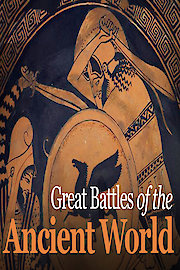
























Hollywood has gone to elaborate lengths to recreate the violence and mayhem of ancient warfare in media. But what were ancient battles really like? What weapons, tactics, armor, training, and logistics were used? In this course, Professor Garrett G. Fagan takes you into the thick of combat in some of the most notable battles fought in the ancient Mediterranean.
Great Battles of the Ancient World is a series that ran for 1 seasons (24 episodes) between November 21, 2024 and on The Great Courses
-
Channel
-
Premiere DateNovember 21, 2024

-
 Stream other movies like this for free.
Stream other movies like this for free.
-
 Find something to watch for free.
Find something to watch for free.
-
 Anytime, Anywhere
Anytime, Anywhere

 Stream other movies like this for free.
Stream other movies like this for free.
 Find something to watch for free.
Find something to watch for free.
 Anytime, Anywhere
Anytime, Anywhere



















